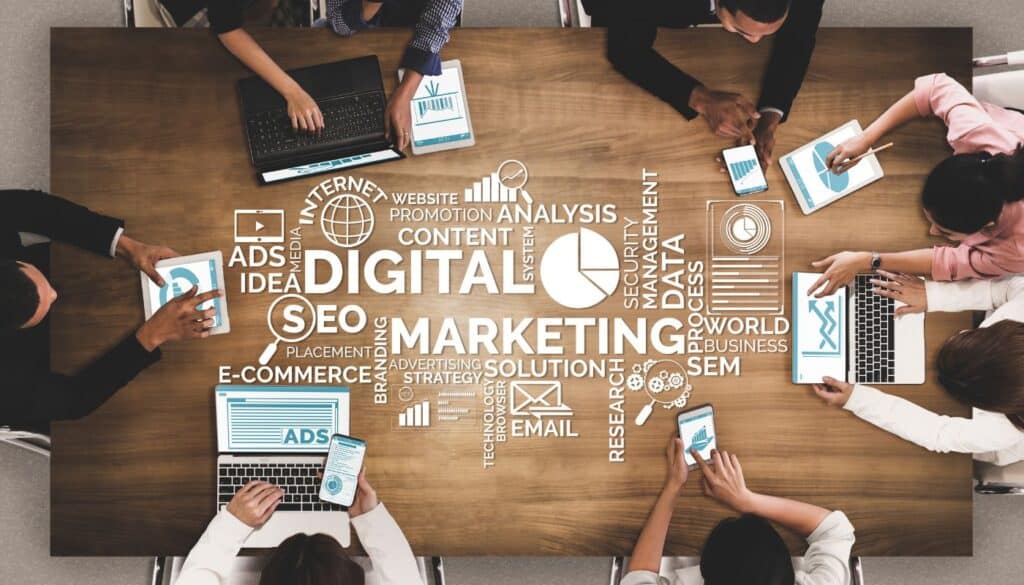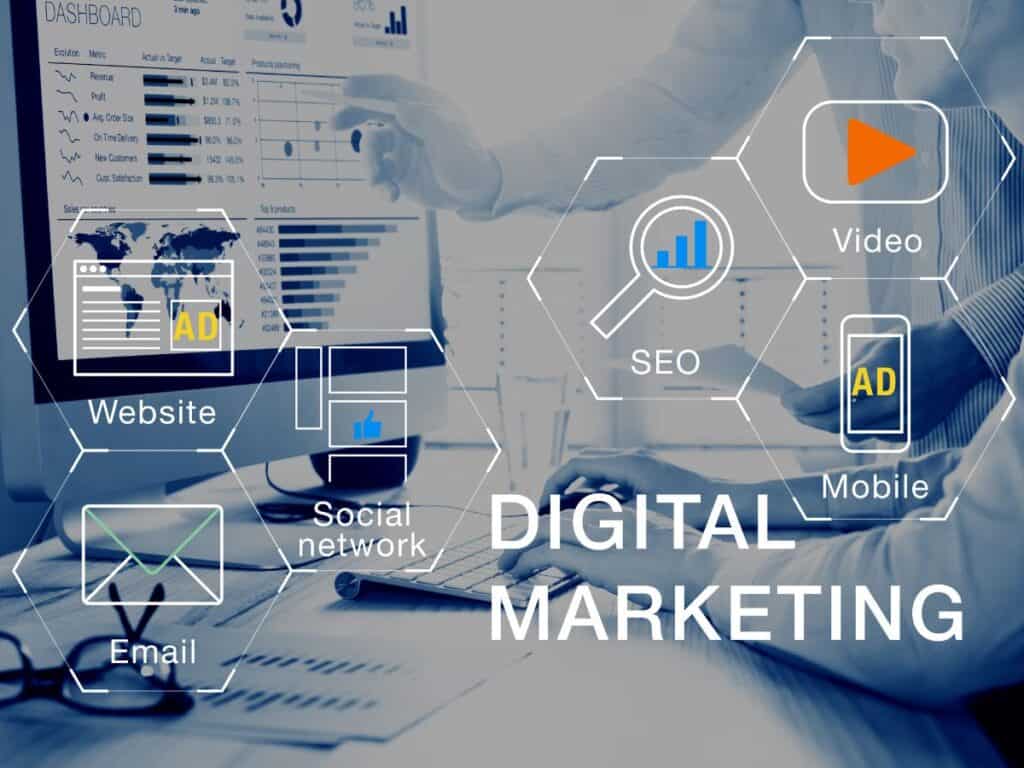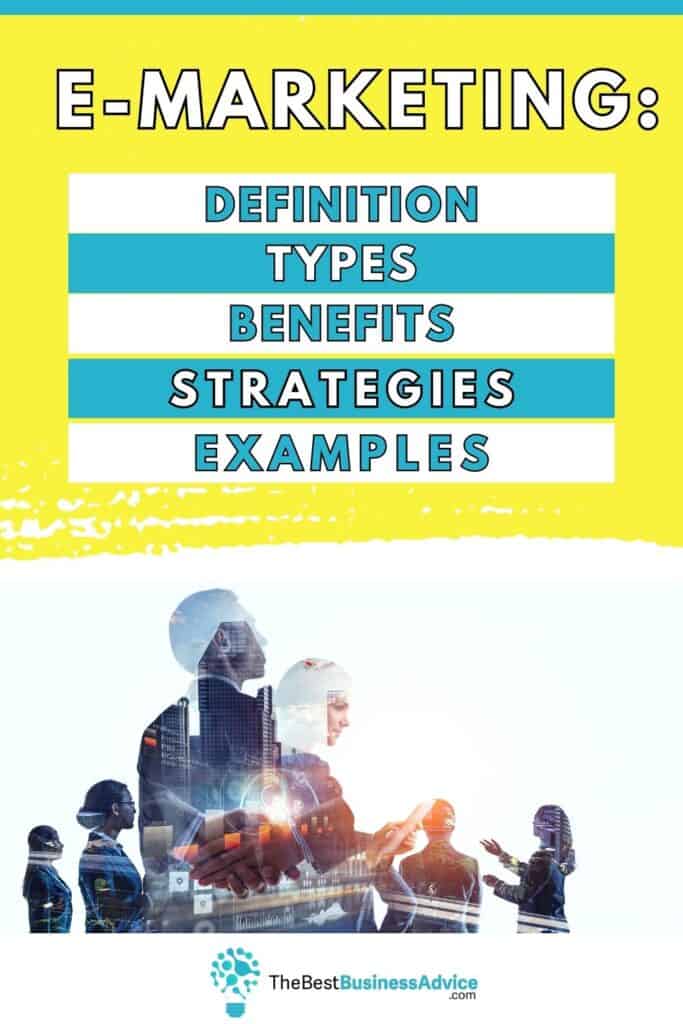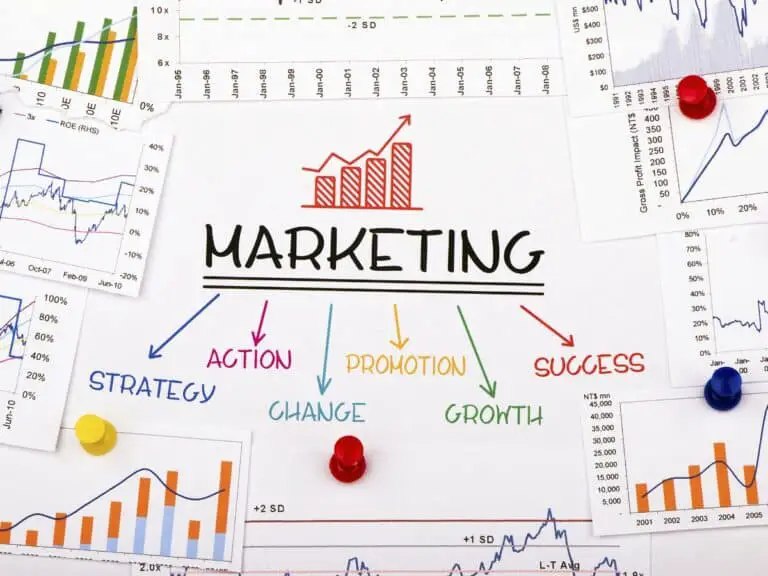E-Marketing: Definition, Types, Benefits, Strategies, And Examples
Since its genesis, marketing has experienced a series of metamorphoses. You may be familiar with the more traditional forms of marketing like magazine ads, billboards, and TV commercials, but how much do you know about e-marketing?
E-marketing is a modern business practice that uses the Internet and other electronic means to buy and sell goods, services, and information. Types of digital marketing include SEO, pay-per-click, marketing analytics, and email, social media, affiliate, content, and mobile marketing.
Online marketing, digital marketing, internet marketing, and web marketing are all synonymous terms for e-marketing (electronic marketing). Businesses increasingly depend on e-marketing to assist their marketing efforts.
Let’s explore the definition, types, benefits, and strategies of e-marketing.
Table of Contents
- E-Marketing Definition
- Types Of E-Marketing
- Benefits Of E-Marketing
- Strategies In E-Marketing
- 1. Optimize SEO
- 2. Produce Original Content
- 3. Hop Onto The Right Social Media Channels
- 4. Start An Email List
- 5. Leverage Promotional Codes
- 6. Incorporate Affiliate Marketing
- 7. Establish Kpis With Marketing Analytics
- 8. Research Target Customers
- 9. Utilize Split Testing
- 10. Double On Working Initiatives
- 11. Analyze & Adjust
- 12. Ask Customers For Feedback
- Features Of E-Marketing
- E-Marketing Pros And Cons
- E-Marketing Real-Life Examples
- Wrap Up
- PIN THIS FOR LATER…
E-Marketing Definition
E-marketing refers to the application of marketing principles, tactics, and operations via electronic media, the world wide web, and the Internet to market a specific brand.
The E-marketing strategy pairs direct and indirect response marketing with various marketing tactics and technologies to connect with potential clients and retain present customers. It allows businesses to establish brand identity, market their products and services, and share new product ideas and information.
The digital marketing world continues to expand and evolve thanks to technological advances. Examples of digital marketing include email marketing, affiliate marketing, websites, banner ads, SEO, social media, blogging, YouTube videos, and more.

E-marketing definitions by different authors:
- Smith & Chaffey – “Achieving marketing objectives through applying digital technologies.”
- Strauss & Frost – “The use of electronic data and applications for planning and executing the conception, distribution, and pricing of ideas, goods, and services to create exchanges that satisfy individual and organizational objectives.”
- McDonald & Wilson – “Any use of technology to achieve marketing objectives.”
- Reedy & Schullo – “The process aimed at facilitating and conducting of business communication and transactions over networks.”
Even though e-marketing seems like a new world, its concept is based on most foundational marketing knowledge and principles. The two disciplines connect with a distinct group of consumers. Traditional marketing reaches a broad consumer base, while electronic marketing is designed to reach a specific audience.
Types Of E-Marketing
E-marketing can be broadly divided into 8 primary categories, including:
- Search Engine Optimization (SEO)
- Pay-per-Click
- Social Media Marketing
- Content Marketing
- Email Marketing
- Mobile Marketing
- Marketing Analytics
- Affiliate Marketing

Search Engine Optimization (SEO)
SEO is an online marketing process that aims to improve a company’s website position and visibility in Google, Microsoft, Bing, or other search engines. It improves a business’s traffic from an editorial or organic (non-paid) search results.
SEO marketers research and identify keywords and phrases with good online traffic potential and use them in their own content.
Pay-Per-Click (PPC) Marketing
PPC is a type of e-marketing strategy where marketers and advertisers pay a publisher every time a visitor clicks on one of their ads.
PPC is like the paid alternative to SEO. Advertisers bid on keywords and phrases for their ads to appear in search engine results. The ad appears among the top results when a user searches for a product or service using one of those keywords or phrases.
PPC advertising is done through search engines like Google Ads, YouTube ads, Facebook Instagram, and display advertising on websites.
Social Media Marketing
Social media marketing involves everything a company does via social media platforms to market its products and services.
SMM can comprise organic and paid marketing. They aim to induce interest, increase brand awareness, improve consumer engagement, attain customer loyalty, strengthen relationships, and generate sales leads.
Example: Apple – #ShotoniPhone
Apple’s “Shot on iPhone” campaign is one of social media’s top user-generated content (UGC) campaigns. What started out as a simple UGC challenge to increase the credibility of the iPhone camera exploded into over 20 million generated posts on Instagram alone.
Companies can use Google, YouTube, Facebook, Instagram, Twitter, Pinterest, etc., to market products, services, and ideas.
Content Marketing
Content marketing focuses on increasing brand awareness through information sharing and storytelling. Companies implement the strategy by creating and distributing relevant content to an online target audience.
Content marketing examples include:
- Blog posts
- Social media posts
- Emails
- Newsletters
- White papers
- Ebooks
- Podcasts
- Videos
Ultimately, the goal is to get readers to take action toward becoming customers, like making a purchase, requesting more information, or signing up for an email list.
Email Marketing
Email marketing is one of the most effective e-marketing techniques. It can provide value to consumers and can convert your audience into customers.
Email marketing campaigns help businesses:
- Stay in touch with their customer base
- Introduce new products and services
- Provide discounts and promotions
Email marketing software offers analytical measures that marketers can improve. The most common factors are:
- The open rate: the number of recipients who opened the email.
- The click-through rate: the number of recipients who opened and clicked on the link in the email.
Mobile Marketing
Mobile marketing focuses on reaching the target audience on their smartphone, tablet, or laptop through text messages, emails, social media, websites, and mobile apps.
In late 2022, Statista conducted a survey, in which over 70% of all global retail website visits were via smartphones.
Marketing Analytics
Highly analytic trackability and measurability are one of the most significant advantages of e-marketing. Analytics allow marketers to track user behavior in extreme detail, including:
- How many times consumers click on a link
- How much time consumers spend on a web page
- How often consumers open emails
- and much more.
Marketing analytics allow marketers to learn what works and doesn’t and adapt their marketing strategies, tools, and messages for future success.
Google Analytics is a popular tool for marketing analytics. It helps marketers understand site and app users better to ensure optimal performance.
Affiliate Marketing
Affiliate market – or influencer marketing – bridges the gap between organizations and consumers. Businesses collaborate with third-party industry experts and influencers to promote their products and services for compensation.
The influencers engage their audience with social media posts, blogs, or videos to create new leads and bring in more business for the organization. Affiliate marketing platforms include Google, TikTok, YouTube, Instagram, and more.
Benefits Of E-Marketing
The Internet has transformed how we live, think, and communicate. In the same way, it has opened up a world of opportunities and benefits to marketers. Here are the main benefits of e-marketing:
- Digital marketing can achieve unlimited viewers.
- E-marketing is cost-effective.
- Businesses can reach a larger audience in less time.
- The impact and efficacy of electronic marketing are easier to appraise and track than traditional marketing.
- Allows direct contact with customers.
- It is a highly interactive way to reach an audience.
- Attains highly valuable consumer feedback.
- E-marketing is personal. It can be automated and responsive to a consumer’s behavior, providing relevant, timely, and personalized information.

Strategies In E-Marketing
It is vital for a company to stay updated with the most current digital marketing trends and techniques to ensure success. Here are the e-marketing strategies worth your time and investment.
1. Optimize SEO
It’s no secret that Google ranks number one in where consumers find businesses. Take necessary steps to ensure your content conforms to SEO best practices.
Research what your target audience is searching for and create unique educational content that addresses common queries.
Lastly, consider the more technical aspects, including URL structuring, page load speed, and mobile optimization. You can use a website builder with SEO in mind to speed up the process.
2. Produce Original Content
Create high-quality, creative, and original content that resonates with consumers. Original content will draw customer interaction and sales and increase your following.
Google aims to rank the best content at the top of its search list.
3. Hop Onto The Right Social Media Channels
Only use social media platforms that align with your target audience.
For example, TikTok’s primary users are 18 to 24 years old. So if your target audience is middle-aged consumers, advertising there won’t make sense.
The best strategy is to use two to three platforms your ideal customers frequently use. This ensures the right eye for your content and lower marketing costs.
4. Start An Email List
An email list may seem like old technology, but it remains one of the most powerful marketing tools. Email marketing generates an average of $36 for every $1 spent, according to a litmus survey in 2022.
Nurture leads by creating something valuable like a checklist, ebook, or mini-course and offering it as a free giveaway in exchange for the user’s email address. Then, you can start sending educational content until they become a customer.
5. Leverage Promotional Codes
Advertise products and services with a unique promotional code that gives the user a unique digital download gift with their purchase.
This allows you to measure how many purchases you gained from that strategy. You can also change the codes with different advertising channels to identify which one is working the best.
6. Incorporate Affiliate Marketing
Affiliate marketers guarantee a return on investment (ROI) for e-marketing campaigns. Companies only pay for the conversions – once you sell a product or gain a customer.
7. Establish Kpis With Marketing Analytics
Ensure the best chances of ROI when implementing a new online campaign by establishing key performance indicators (KPI) with marketing analytics. They help measure the progress of predetermined business goals.
Some key performance indicators worth measuring include the total
- Opportunities
- Visitors
- Leads
- Qualified leads
- Conversion rates
8. Research Target Customers
Thorough consumer research is the best way to ensure returning customers. Ensure you establish who your target market is to prevent wasting funds on reaching the wrong group of people.
Research helps:
- Identify your users’ needs, demands, and desires.
- Identify which social media platforms are mostly used by your target group.
- To know where customers are online.
- To add value to customers’ lives with high-quality content.
9. Utilize Split Testing
Implement split testing or A/B testing on two versions of the same content to compare which one performs better. This will help get a better return on e-marketing efforts.
For example, a company can create two variations of an advertisement to test which one gets more clicks.
10. Double On Working Initiatives
Identify which e-marketing strategy is making the most money or attracting the most clients – SEO, email marketing, pay-per-click, etc. – and double down on those initiatives.
11. Analyze & Adjust
If your marketing strategy isn’t delivering the expected results, pause, pivot, and adjust.
For example, if your website isn’t converting visitors, run a split test with different calls to action to see what performs best.
12. Ask Customers For Feedback
Ask customers for feedback and use the information to fine-tune and improve your strategy or to create value for your customers. Most people gladly share their likes and dislikes about your marketing strategy.

Features Of E-Marketing
Some essential features of e-marketing include:
- Cheaper than traditional marketing: e-marketing allows you to reach a wider audience with limited resources. It eliminates costs like newspaper ads, magazines, and billboards.
- Tangible ROI: Small companies can check the ROI with the help of modern technology that analyzes the number of sales, clicks on a link, and views on a video.
- 24/7 Approach: e-marketing works year-round, 24 hours daily and 7 days a week, whether you’re at home or work.
- Eliminates Follow-up Failure: An automated marketing system shows custom-tailored details about your company and its progress. It includes which areas you should expand and quit.
E-Marketing Pros And Cons
E-marketing has favorable benefits, but it comes with its downsides too. Deciding whether or not e-marketing is worthwhile depends on individual companies. Here are the pros and cons of digital marketing.
| Advantages of E-marketing | Disadvantages of E-marketing |
| Instant responseCost-efficientCost reduction by automationPersonalized marketingInteractiveGreater product exposure Greater data collectionLess riskyAccessible across the globe | Technology dependentGlobal competitionMaintenance costsHigher transparency and price competitionPrivacy and security issues |
E-Marketing Real-Life Examples
True success in e-marketing involves understanding the digital world and e-commerce and immersing yourself in various skill sets before diving in headfirst.
Here are some real-life examples of e-marketing done the right way.
Heineken – #openyourworld Campaign
In this e-marketing campaign, Heineken chose an interesting way to tell. Instead of focusing on a single narrative, they highlighted the world’s differences by telling a story with emotional triggers.
The ad pairs people with conflicting views on topics like climate change, feminism, and transgenderism. They are asked to complete several tasks and then look at their partners’ interviews. Afterward, they can leave or stay and discuss their different opinions over a beer – a Heineken beer, of course.
The campaign inspired an emotional response and received over 17.7 million views and over 138,000 shares on Facebook.
AirBnB – Perfected Social Media Marketing
AirBnB is one of the best examples of excellent digital marketing. The US company relies on authentic photos and videos to promote its services.
Since its beginning in 2007, the company has gained a market cap of $74.68 Billion.
Red Bull – The Power of Viral Content
Instead of following traditional marketing approaches, Red Bull uses the power of viral content to create a brand identity, generate awareness, boost sales, and gain fans.
The company uses extreme sports campaigns or even series like Red Bull Air Race, Red Bull Cliff Diving World Series, Red Bull Crashed Ice, and stunts like Red Bull Stratos to earn millions of new fans.
The biggest marketing stunt Red Bull pulled off was in 2012 when Felix Baumgartner free-fell out of a hot air balloon 127,851ft in space. The stunt attracted millions of viewers globally and was mentioned for months, even years, after it happened.
Red Bull sold more than 11.582 billion cans globally in 2022.
Wrap Up
E-marketing has expanded substantially over the past years and continues to evolve as a discipline. A business can use these technological advances to create a bright future.
PIN THIS FOR LATER…
DID YOU FIND THIS INFORMATION HELPFUL? Share the love on social.
Follow us on Pinterest & Instagram!
ANY OTHER BUSINESS ADVICE WE CAN WRITE ABOUT?

![]()








